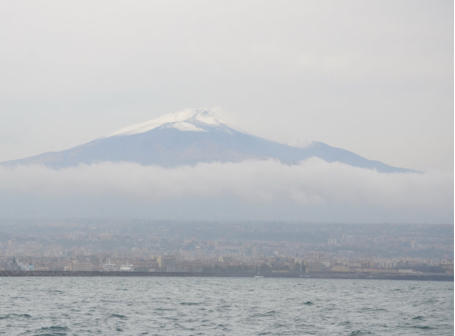



Our Wakes: 2017








The Messina Strait: (28 May 2017)

The Strait of Messina are a 3.5km long narrow passage that separates Italy from Sicily. There can be a lot of commercial boats passing through the Strait and depending on the tide, you can
can be a lot of commercial boats passing through the Strait and depending on the tide, you can have currents running at up to 4 knots. If the wind is against the current, you can face choppy
have currents running at up to 4 knots. If the wind is against the current, you can face choppy seas that make the passage difficult. To prevent boat collisions, the authorities have divided
seas that make the passage difficult. To prevent boat collisions, the authorities have divided the Straights into 2 lanes in which you can only move in one direction. We were well prepared
the Straights into 2 lanes in which you can only move in one direction. We were well prepared for the passage through the Strait and encountered no difficulties. Traffic was light and only
for the passage through the Strait and encountered no difficulties. Traffic was light and only one Malteses cargo ship on its way to Malta passed next to us. When entering the Strait from
one Malteses cargo ship on its way to Malta passed next to us. When entering the Strait from the north you notice two huge pylons on each side. In the past, power cables were supported by
the north you notice two huge pylons on each side. In the past, power cables were supported by them to supply power to Sicily. Today, the cables are underwater and only the pylons remain to
them to supply power to Sicily. Today, the cables are underwater and only the pylons remain to guard the entrance to the Straits.
guard the entrance to the Straits.
 We did see three traditional boats that were out hunting swordfishes. Those boats are sailing
We did see three traditional boats that were out hunting swordfishes. Those boats are sailing only when the sea is calm for obvious reasons. Luckily on the web there are several videos of
only when the sea is calm for obvious reasons. Luckily on the web there are several videos of those boats in action. Those boats are quite impressive as they have a tower up to 30 meters
those boats in action. Those boats are quite impressive as they have a tower up to 30 meters high on which 2 to 4 crew members stands watching the surface of the sea. In the front of the
high on which 2 to 4 crew members stands watching the surface of the sea. In the front of the boat there is a big prow 20 meters long occupied by the harpoonist.
boat there is a big prow 20 meters long occupied by the harpoonist. 
 The thing that surprised us the most was the number of white butterflies (more then 100) that
The thing that surprised us the most was the number of white butterflies (more then 100) that were crossing the Strait. They did not stop on Terus for a little rest; they were determined to
were crossing the Strait. They did not stop on Terus for a little rest; they were determined to reach Sicily. We learned afterwards that those cabbage whites were coming from Africa and
reach Sicily. We learned afterwards that those cabbage whites were coming from Africa and migrate usually in May. Once we had finished navigating the seaway, we raised the sails and we
migrate usually in May. Once we had finished navigating the seaway, we raised the sails and we were moving nicely to the outh. At 3pm we reached Taormina that offered us a well-protected
were moving nicely to the outh. At 3pm we reached Taormina that offered us a well-protected  mooring for the night. Taormina located well above sea-level looked quiet as all the G7 summit
mooring for the night. Taormina located well above sea-level looked quiet as all the G7 summit guests had returned home to their own countries.Taormina is very much appreciated by the
guests had returned home to their own countries.Taormina is very much appreciated by the tourists as it has a well preserved Greek theater and offers also a very beautifull view on the
tourists as it has a well preserved Greek theater and offers also a very beautifull view on the Messina Strait.
Messina Strait.

 can be a lot of commercial boats passing through the Strait and depending on the tide, you can
can be a lot of commercial boats passing through the Strait and depending on the tide, you can have currents running at up to 4 knots. If the wind is against the current, you can face choppy
have currents running at up to 4 knots. If the wind is against the current, you can face choppy seas that make the passage difficult. To prevent boat collisions, the authorities have divided
seas that make the passage difficult. To prevent boat collisions, the authorities have divided the Straights into 2 lanes in which you can only move in one direction. We were well prepared
the Straights into 2 lanes in which you can only move in one direction. We were well prepared for the passage through the Strait and encountered no difficulties. Traffic was light and only
for the passage through the Strait and encountered no difficulties. Traffic was light and only one Malteses cargo ship on its way to Malta passed next to us. When entering the Strait from
one Malteses cargo ship on its way to Malta passed next to us. When entering the Strait from the north you notice two huge pylons on each side. In the past, power cables were supported by
the north you notice two huge pylons on each side. In the past, power cables were supported by them to supply power to Sicily. Today, the cables are underwater and only the pylons remain to
them to supply power to Sicily. Today, the cables are underwater and only the pylons remain to guard the entrance to the Straits.
guard the entrance to the Straits.
 We did see three traditional boats that were out hunting swordfishes. Those boats are sailing
We did see three traditional boats that were out hunting swordfishes. Those boats are sailing only when the sea is calm for obvious reasons. Luckily on the web there are several videos of
only when the sea is calm for obvious reasons. Luckily on the web there are several videos of those boats in action. Those boats are quite impressive as they have a tower up to 30 meters
those boats in action. Those boats are quite impressive as they have a tower up to 30 meters high on which 2 to 4 crew members stands watching the surface of the sea. In the front of the
high on which 2 to 4 crew members stands watching the surface of the sea. In the front of the boat there is a big prow 20 meters long occupied by the harpoonist.
boat there is a big prow 20 meters long occupied by the harpoonist. 
 The thing that surprised us the most was the number of white butterflies (more then 100) that
The thing that surprised us the most was the number of white butterflies (more then 100) that were crossing the Strait. They did not stop on Terus for a little rest; they were determined to
were crossing the Strait. They did not stop on Terus for a little rest; they were determined to reach Sicily. We learned afterwards that those cabbage whites were coming from Africa and
reach Sicily. We learned afterwards that those cabbage whites were coming from Africa and migrate usually in May. Once we had finished navigating the seaway, we raised the sails and we
migrate usually in May. Once we had finished navigating the seaway, we raised the sails and we were moving nicely to the outh. At 3pm we reached Taormina that offered us a well-protected
were moving nicely to the outh. At 3pm we reached Taormina that offered us a well-protected  mooring for the night. Taormina located well above sea-level looked quiet as all the G7 summit
mooring for the night. Taormina located well above sea-level looked quiet as all the G7 summit guests had returned home to their own countries.Taormina is very much appreciated by the
guests had returned home to their own countries.Taormina is very much appreciated by the tourists as it has a well preserved Greek theater and offers also a very beautifull view on the
tourists as it has a well preserved Greek theater and offers also a very beautifull view on the Messina Strait.
Messina Strait.






























